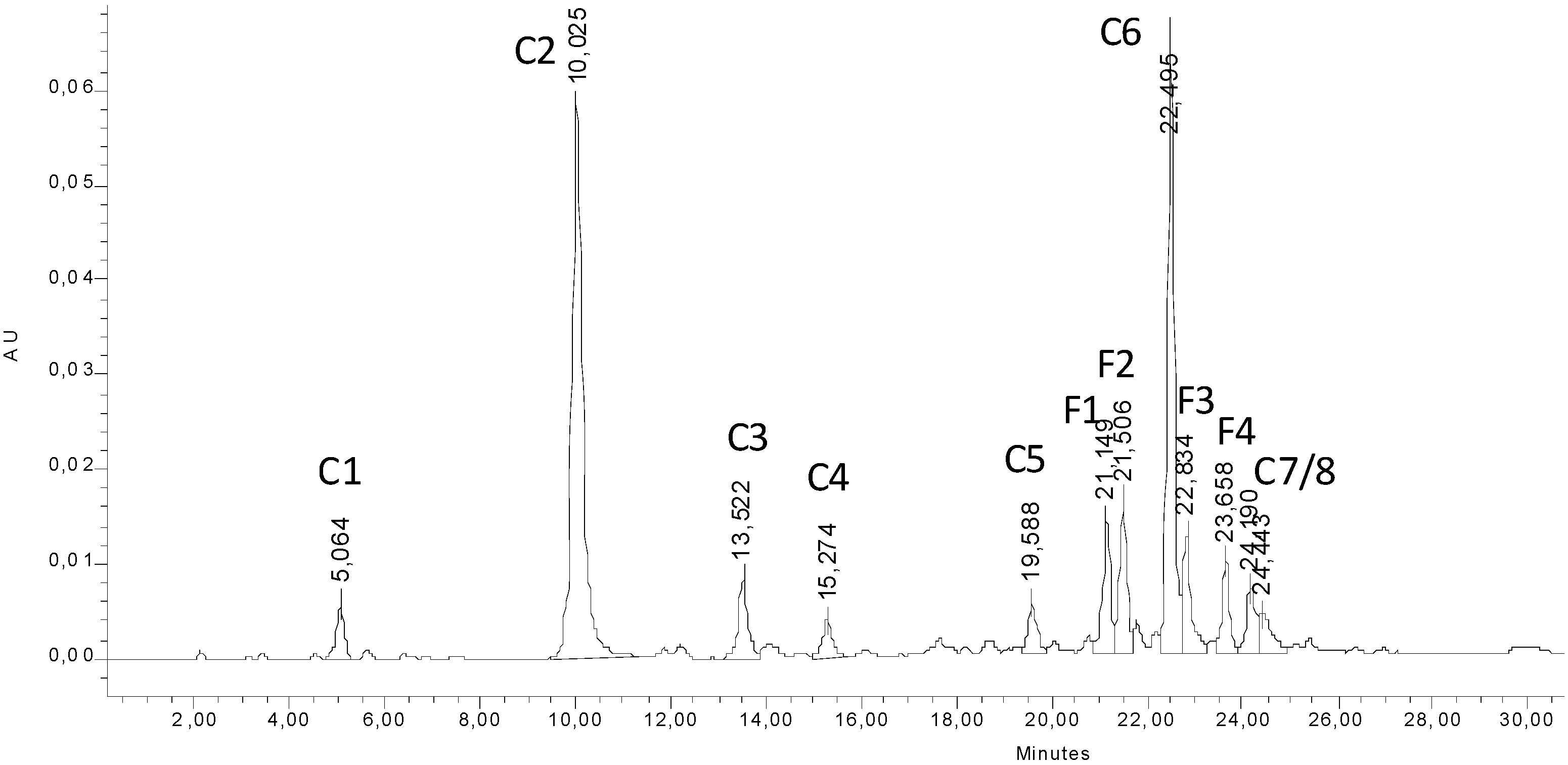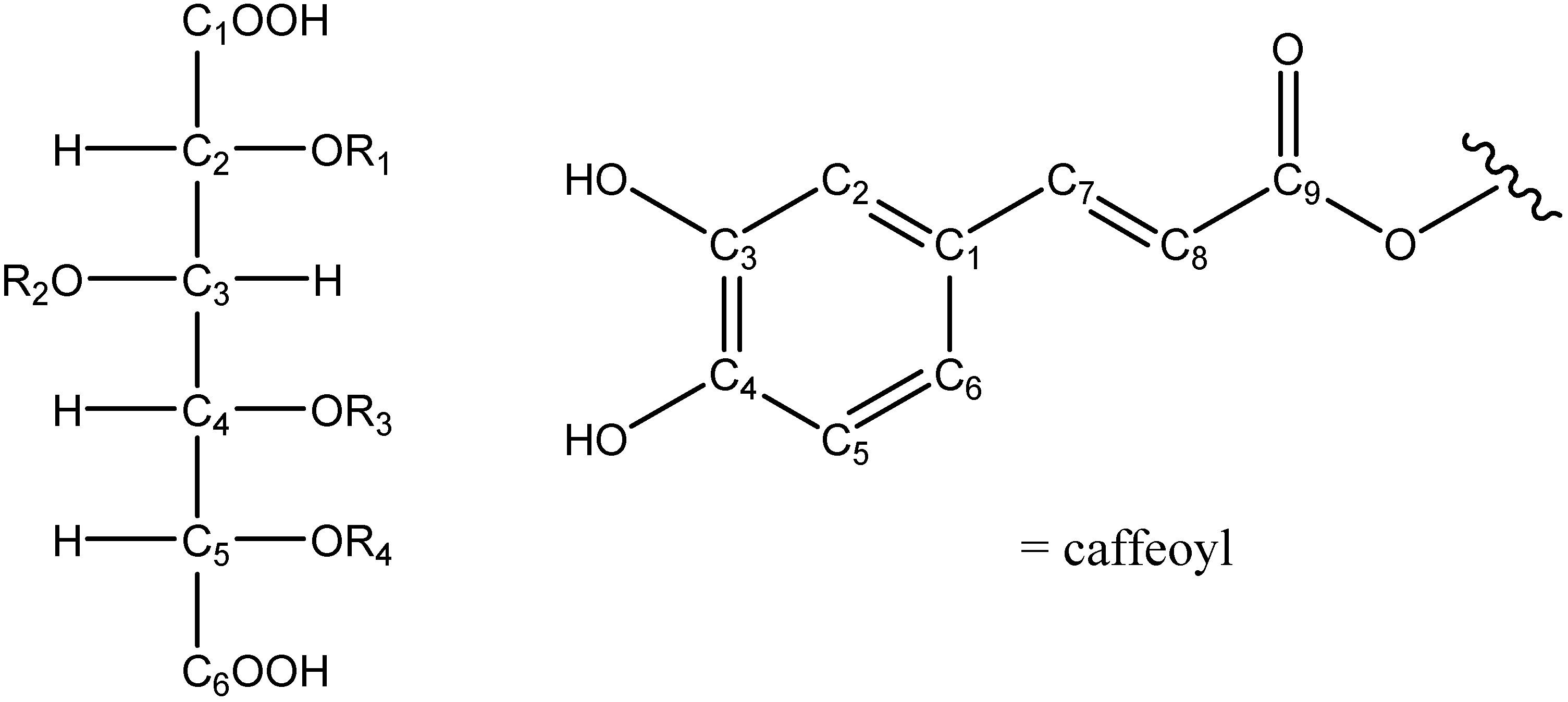Caffeic Acid Derivatives from Eupatorium perfoliatum L.
Abstract
:Introduction
Results and Discussion


Experimental
General
Plant material
Extraction and isolation
2,4-/3,5-Dicaffeoylglucaric acid (C3)
3,4-Dicaffeoylglucaric acid (C4)
2,5-Dicaffeoylglucaric acid (C5)
Acknowledgements
References and Notes
- Locock, R. A. Boneset Eupatorium. C. P. J. 1990, 123, 229–233. [Google Scholar]
- Hall, T. B., Jr. Eupatorium perfoliatum. A plant with a history. Mo. Med. 1974, 71, 527–528. [Google Scholar]
- Madaus, G. Abteilung I: Heilpflanzen. In Lehrbuch der biologischen Heilmittel; Georg-Thieme-Verlag: Leipzig, Germany, 1938; Vol. 2. [Google Scholar]
- Moerman, D. E. Medicinal Plants of Native America, Volume One; University of Michigan Publishers: Ann Arbor, Michigan, USA, 1986. [Google Scholar]
- Habtemariam, S. Activity-guided isolation and identification of free radical-scavenging components from ethanolic extract of boneset (leaves of Eupatorium perfoliatum). Nat. Prod. Commun. 2008, 3, 1317–1320. [Google Scholar]
- Wagner, H.; Iyengar, M. A.; Hoerhammer, L.; Herz, W. Flavonol-3-glucosides in eight Eupatorium species. Phytochemistry 1972, 11, 1504–1505. [Google Scholar] [CrossRef]
- Herz, W.; Gibaja, S.; Bhat, S. V.; Srinivasan, A. Dihydroflavonols and other flavonoids of Eupatorium species. Phytochemistry 1972, 11, 2859–2863. [Google Scholar] [CrossRef]
- Herz, W.; Kalyanaraman, P. S.; Ramakrishnan, G.; Blount, J. F. Sesquiterpene lactones of Eupatorium perfoliatum. J. Org. Chem. 1977, 42, 2264–2271. [Google Scholar] [CrossRef]
- Bohlmann, F.; Mahanta, P. K.; Suwita, A.; Suwita, A.; Natu, A. A.; Zdero, C.; Dorner, W.; Ehlers, D.; Grenz, M. Neue Sesquiterpenlactone und andere Inhaltsstoffe aus Vertretern der Eupatorium-Gruppe. Phytochemistry 1977, 16, 1973–1981. [Google Scholar] [CrossRef]
- Herz, W. Chemistry of the Eupatoriinae. Biochem. Syst. Ecol. 2001, 29, 1115–1137. [Google Scholar] [CrossRef]
- Dominguez, X. A.; Quintanilla, J. A.; Gonzalez; Rojas, M. P. Chemistry of Mexican Eupatorium genus. III. Sterols and triterpenes from Eupatorium perfoliatum. Phytochemistry 1974, 13, 673–674. [Google Scholar] [CrossRef]
- Hooper, S. N.; Chandler, R. F. Herbal remedies of the Maritime [Canada] Indians: phytosterols and triterpenes of 67 plants. J. Ethnopharmacol. 1984, 10, 181–194. [Google Scholar] [CrossRef]
- Woerdenbag, H. J.; Bos, R.; Hendriks, H. Eupatorium perfoliatum L. - der "durchwachsene" Wasserhanf. Z. Phytother. 1992, 13, 134–139. [Google Scholar]
- Vollmar, A.; Schaefer, W.; Wagner, H. Immunologically active polysaccharides of Eupatorium cannabinum and Eupatorium perfoliatum. Part II. Phytochemistry 1986, 25, 377–381. [Google Scholar] [CrossRef]
- Wagner, H.; Proksch, A.; Riess-Maurer, I.; Vollmar, A.; Odenthal, S.; Stuppner, H.; Jurcic, K.; Le Turdu, M.; Fang, J. N. Immunostimulating polysaccharides (heteroglycans) of higher plants. Arzneimittelforschung 1985, 35, 1069–1075. [Google Scholar]
- Wagner, H.; Proksch, A.; Vollmar, A.; Kreutzkamp, B.; Bauer, J. In vitro phagocytosis stimulation by isolated plant materials measured in the phagocytosis-chemoluminescence (CL) model. Planta Med. 1985, 139–144. [Google Scholar]
- Nauert, C.; Bentley, C.; Fiebich, B. L. In-vitro-Untersuchung zur entzündungshemmenden Wirkung von Eupatorium perfoliatum (EP). Z. Phytother. 2006, Supplement 1, 27. [Google Scholar]
- Benoit, P. S.; Fong, H. H. S.; Svoboda, G. H.; Farnsworth, N. R. Biological and Phytochemical Evaluation of Plants. XIV. Antiinflammatory Evaluation of 163 Species of Plants. Lloydia 1976, 39, 160–171. [Google Scholar]
- Habtemariam, S.; Macpherson, A. M. Cytotoxicity and antibacterial activity of ethanol extract from leaves of a herbal drug, boneset (Eupatorium perfoliatum). Phytother. Res. 2000, 14, 575–577. [Google Scholar] [CrossRef]
- Lira-Salazar, G.; Marines-Montiel, E.; Torres-Monzon, J.; Hernandez-Hernandez, F.; Salas-Benito, J. S. Effects of homeopathic medications Eupatorium perfoliatum and Arsenicum album on parasitemia of Plasmodium berghei-infected mice. Homeopathy 2006, 95, 223–228. [Google Scholar] [CrossRef]
- Bentley, C.; Grünwald, J. Behandlung von 300 Säuglingen, Kleinkindern und Kindern mit akutem grippalem Infekt: Therapieerfolge einer fixen Wirkstoffkombination (Contramutan). Z. Phytother. 2006, Supplement 1, 28. [Google Scholar]
- Elsässer-Beile, U.; Willenbacher, W.; Bartsch, H. H.; Gallati, H.; Schulte, M. J.; von Kleist, S. Cytokine production in leukocyte cultures during therapy with Echinacea extract. J. Clin. Lab. Anal. 1996, 10, 441–445. [Google Scholar] [CrossRef]
- Gassinger, C. A.; Wunstel, G.; Netter, P. A controlled clinical trial for testing the efficacy of the homeopathic drug Eupatorium perfoliatum D2 in the treatment of common cold (author's transl). Arzneimittelforschung 1981, 31, 732–736. [Google Scholar]
- Maas, M.; Hensel, A. Eupatorium perfoliatum L. - Alte Arzneipflanze neu entdeckt. Z. Phytother. 2008, 5, 249–254. [Google Scholar] [CrossRef]
- Pauli, G. F.; Kuczkowiak, U.; Nahrstedt, A. Solvent effects in the structure dereplication of caffeoyl quinic acids. Magn. Reson. Chem. 1999, 37, 827–836. [Google Scholar] [CrossRef]
- Kuczkowiak, U. Hydroxyzimtsäurederivate und Flavonoide in offizinellen Crataegus-Arten und einem kommerziellen Extrakt sowie Versuche zur stofflichen Zuordnung der Refraktärzeit-verlängernden Aktivität. Dissertation, Westfälische-Wilhelms-Universität Münster, 2000. [Google Scholar]
- Takenaka, M.; Yan, X.; Ono, H.; Yoshida, M.; Nagata, T.; Nakanishi, T. Caffeic Acid Derivatives in the Roots of Yacon (Smallanthus sonchifolius). J. Agric. Food Chem. 2003, 51, 793–796. [Google Scholar] [CrossRef]
- Hänsel, R.; Sticher, O. Pharmakognosie - Phytopharmazie; Springer-Verlag: Heidelberg, Germany, 2004; p. 1214. [Google Scholar]
- Clavin, M.; Gorzalczany, S.; Macho, A.; Munoz, E.; Ferraro, G.; Acevedo, C.; Martino, V. Anti-inflammatory activity of flavonoids from Eupatorium arnottianum. J. Ethnopharmacol. 2007, 112, 585–589. [Google Scholar] [CrossRef]
- Pagani, F.; Romussi, G. Constituents of Eupatorium cannabinum var syriacum. Farmaco, Ed. Prat. 1967, 22, 771–785. [Google Scholar]
- Lang, G. Phytochemische Untersuchung der Blätter von Eupatorium semialatum Benth., einer in Zentralamerika traditionell verwendeten Arzneipflanze ("Bacché"). Dissertation, Heinrich-Heine-Universität Düsseldorf, 2001. [Google Scholar]
- Elliger, C. A.; Lundin, R. E.; Haddon, W. F. Caffeyl esters of glucaric acid in Lycopersicon esculentum leaves. Phytochemistry 1981, 20, 1133–1134. [Google Scholar] [CrossRef]
- Nagels, L.; Van Dongen, W.; Parmentier, F. Cestric acid, a caffeic acid ester from Cestrum euanthes. Phytochemistry 1982, 21, 743–746. [Google Scholar] [CrossRef]
- Strack, D.; Engel, U.; Weissenboeck, G.; Grotjahn, L.; Wray, V. Ferulic acid esters of sugar carboxylic acids from primary leaves of rye (Secale cereale). Phytochemistry 1986, 25, 2605–2608. [Google Scholar] [CrossRef]
- Risch, B.; Herrmann, K.; Wray, V.; Grotjahn, L. 2'-(E)-O-p-coumaroylgalactaric acid and 2'-(E)-O-feruloylgalactaric acid in citrus. Phytochemistry 1987, 26, 509–510. [Google Scholar] [CrossRef]
- Risch, B.; Herrmann, K.; Wray, V. (E)-O-p-coumaroyl-, (E)-O-feruloyl-derivatives of glucaric acid in citrus. Phytochemistry 1988, 27, 3327–3329. [Google Scholar] [CrossRef]
- Schwaiger, S.; Cervellati, R.; Seger, C.; Ellmerer, E. P.; About, N.; Renimel, I.; Godenir, C.; Andre, P.; Gafner, F.; Stuppner, H. Leontopodic acid - a novel highly substituted glucaric acid derivative from Edelweiss (Leontopodium alpinum Cass.) and its antioxidative and DNA protecting properties. Tetrahedron 2005, 61, 4621–4630. [Google Scholar] [CrossRef]
- Schwaiger, S.; Seger, C.; Wiesbauer, B.; Schneider, P.; Ellmerer, E. P.; Sturm, S.; Stuppner, H. Development of an HPLC-PAD-MS assay for the identification and quantification of major phenolic edelweiss (Leontopodium alpinum Cass.) constituents. Phytochem. Anal. 2006, 17, 291–298. [Google Scholar] [CrossRef]
- Strack, D.; Gross, W.; Wray, V.; Grotjahn, L. Enzymic synthesis of caffeoylglucaric acid from chlorogenic acid and glucaric acid by a protein preparation from tomato cotyledons. Plant Physiol. 1987, 83, 475–478. [Google Scholar] [CrossRef]
- Takenaka, M.; Nanayama, K.; Ono, H.; Nakajima, H.; Isobe, S. Changes in the concentration of phenolic compounds during growing, storing, and processing of yacon. Nippon Shokuhin Kagaku Kogaku Kaishi 2006, 53, 603–611. [Google Scholar] [CrossRef]
- Anonymous. Homöopathisches Arzneibuch 2007: Amtliche Ausgabe, Dt. Apotheker-Verl. [u.a.]: Stuttgart, Germany, 2007.
- Sample Availability: Samples of the compounds C1 to C6 are available from the authors.
© 2009 by the authors; licensee Molecular Diversity Preservation International, Basel, Switzerland. This article is an open access article distributed under the terms and conditions of the Creative Commons Attribution license ( http://creativecommons.org/licenses/by/3.0/).
Share and Cite
Maas, M.; Petereit, F.; Hensel, A. Caffeic Acid Derivatives from Eupatorium perfoliatum L. Molecules 2009, 14, 36-45. https://doi.org/10.3390/molecules14010036
Maas M, Petereit F, Hensel A. Caffeic Acid Derivatives from Eupatorium perfoliatum L. Molecules. 2009; 14(1):36-45. https://doi.org/10.3390/molecules14010036
Chicago/Turabian StyleMaas, Mareike, Frank Petereit, and Andreas Hensel. 2009. "Caffeic Acid Derivatives from Eupatorium perfoliatum L." Molecules 14, no. 1: 36-45. https://doi.org/10.3390/molecules14010036
APA StyleMaas, M., Petereit, F., & Hensel, A. (2009). Caffeic Acid Derivatives from Eupatorium perfoliatum L. Molecules, 14(1), 36-45. https://doi.org/10.3390/molecules14010036



